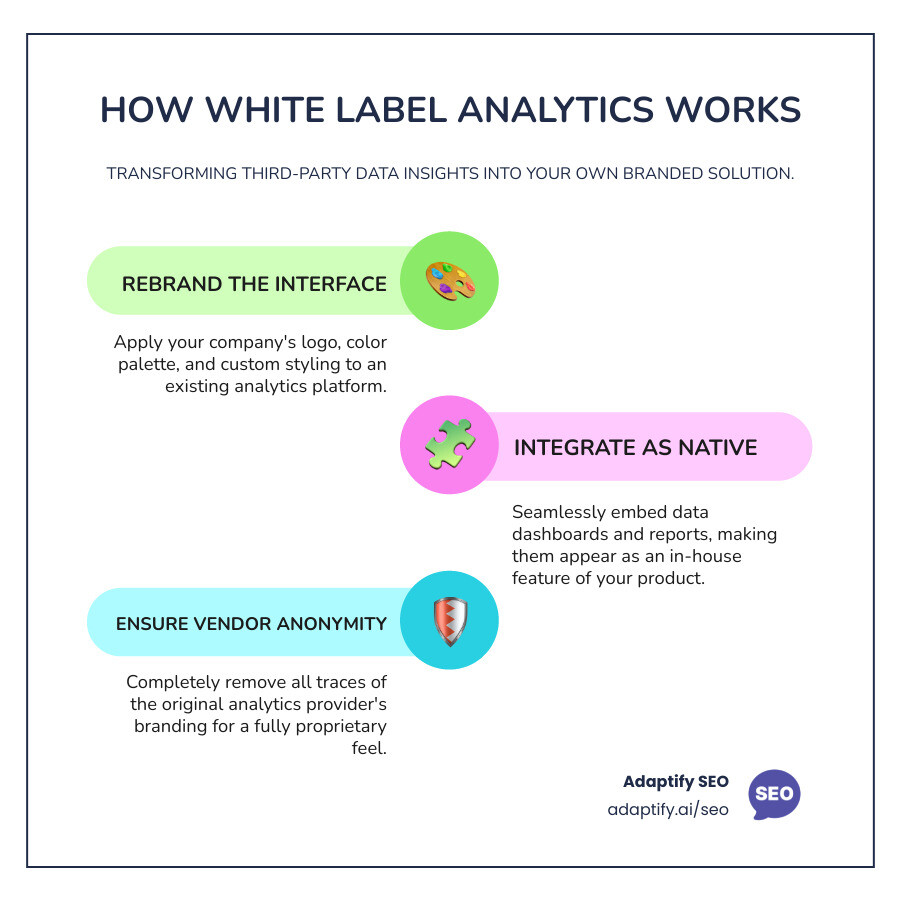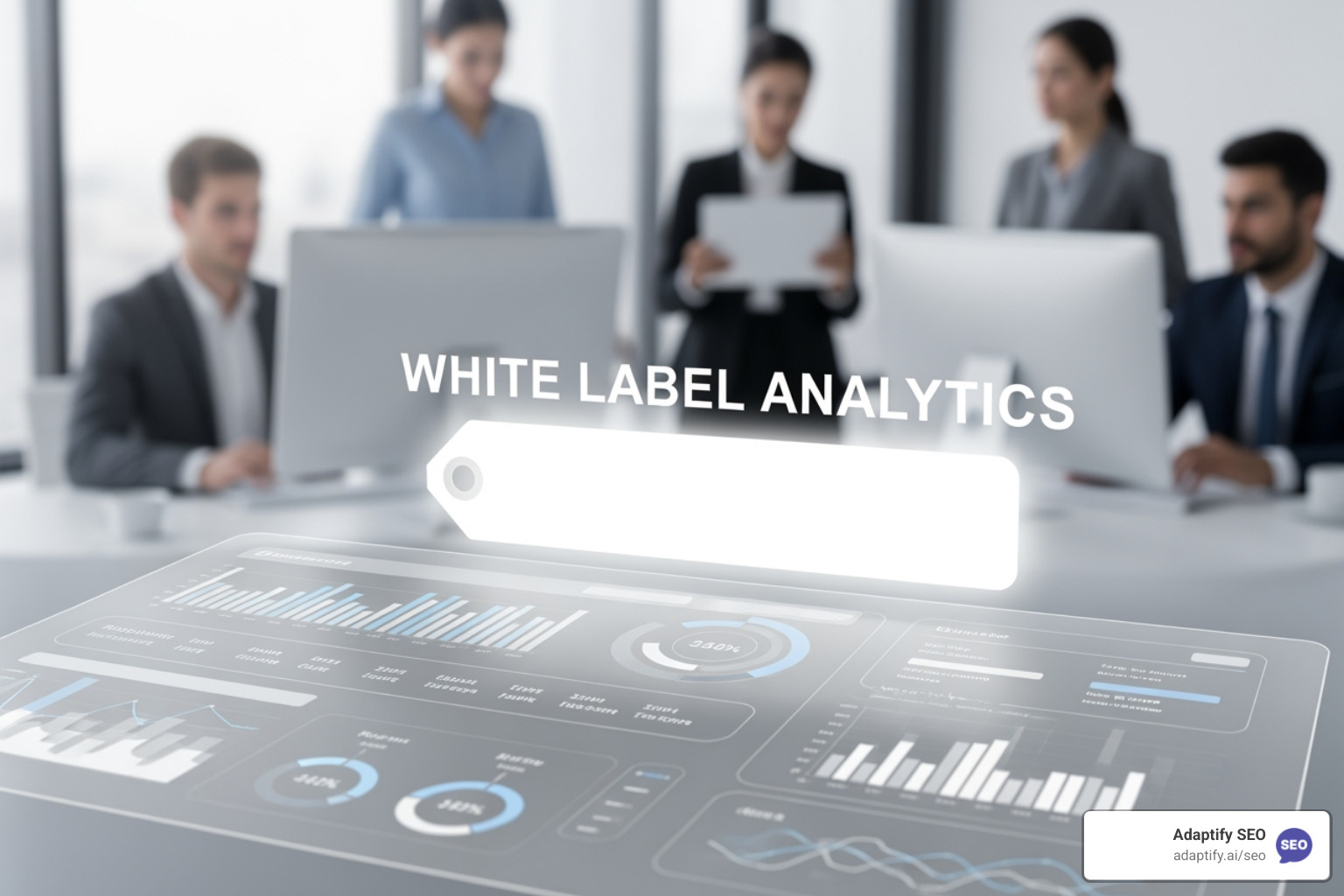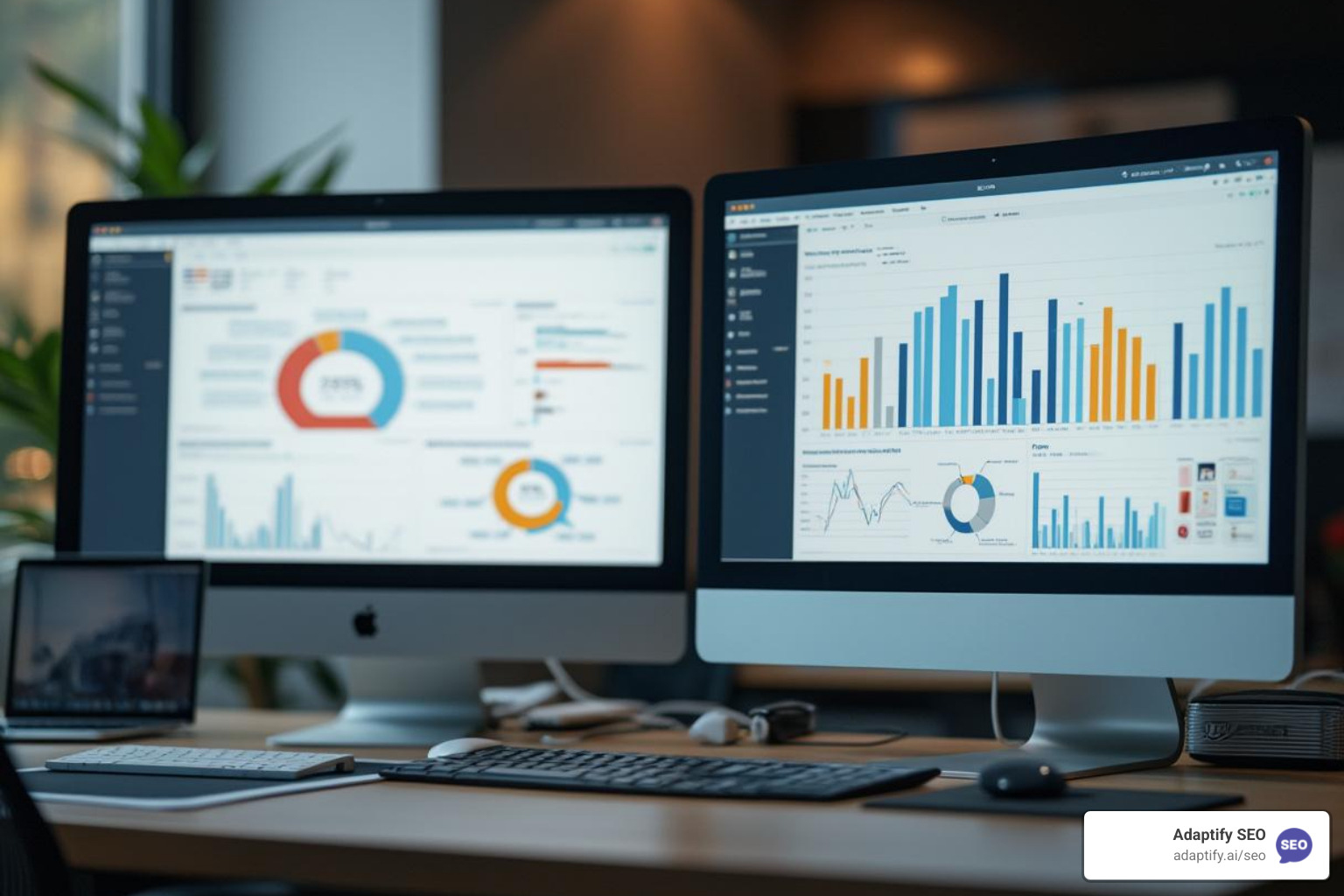The Power of White Label Analytics: Seamlessly Brand Your Data Insights
Hansjan Kamerling
Aug 8
Understanding White Label Analytics

White label analytics is a powerful solution that allows businesses to offer advanced data insights under their own brand, making a third-party analytics tool appear as if it was developed in-house.
It involves:
- Rebranding an existing analytics platform with your company's logo, colors, and styling.
- Presenting data dashboards and reports as a native feature of your own product or service.
- Removing any trace of the original analytics provider's branding.
This approach ensures a seamless, branded experience for your users. As one expert puts it, "The key to white labeling products is anonymity… Your brand gets all of the credibility, loyalty, and trust."
As Hansjan Kamerling, my background includes extensive work in product design and development for SaaS platforms, where I've seen the impact of integrated data solutions. Specifically, I’ve been involved with data analytics platforms that leveraged advanced features, including aspects of white label analytics, to serve a large user base.
This guide will explore how white label analytics can transform your business.

Why White Label Analytics is a Game-Changer for Your Business
In today's data-driven world, strong analytics are essential. Building them from scratch is a major challenge, which is where white label analytics steps in as a true game-changer. It offers a strategic advantage by strengthening your brand, improving user experience, boosting revenue, and providing a competitive edge.
I've personally seen how much product leaders rely on data. In fact, a survey by the Product-led Alliance (PLA) found that a remarkable 57% of product leaders say that embedded analytics directly impacts their revenue. That statistic highlights the value of integrating data insights into your business.
Maintain Brand Consistency and Improve User Experience
One of the biggest benefits of white label analytics is how it maintains brand consistency and improves the user experience. Imagine offering clients an analytics dashboard that feels like a native part of your product, not a clunky third-party tool. That's the magic of white labeling.
With white label analytics, you can seamlessly integrate your custom logos, brand colors, fonts, and even tweak the user interface (UI) to match your application. The goal is to make the analytics experience so smooth that users don't even realize it's a third-party tool. This seamless integration boosts engagement and builds trust. When users see insights within a familiar space, it removes confusion and links those powerful insights directly to your brand. For agencies, removing third-party branding from reports ensures clients aren't confused and your agency gets full credit for its work.
Here at Adaptify.ai, we know how vital it is to present a united brand front. That's why we offer strong white-label SEO services, making sure agencies can provide full SEO solutions under their own name. You can learn more about our white-label SEO services right here: https://adaptify.ai/seo/overview/white-label. It’s all about letting your brand truly shine.
Accelerate Time-to-Market and Reduce Development Costs
The classic "build vs. buy" question is especially important for analytics. Creating a feature-rich analytics platform in-house is a tough, time-consuming, and expensive journey. It demands huge investments in specialized talent, complex tech, and endless maintenance. From my experience, building a BI platform from scratch can be "a long task near impossible to achieve unless you have the expertise, and that costs a lot more money."
This is where white label analytics shines. By choosing a ready-made solution, businesses can dramatically reduce development costs and launch much faster. Instead of spending months or years on development, you can integrate a white-label solution in just weeks. This means you can offer advanced insights to your users sooner, giving you a big competitive advantage.
Furthermore, it frees up your internal resources to focus on what they do best: innovating your core product. This not only saves money but also keeps your business agile. For small and medium-sized businesses, white label analytics is a smart, cost-effective way to offer advanced features without the headache of building them yourself.
Open up New Revenue Streams and Increase User Adoption
Beyond aesthetics and cost savings, white label analytics opens up opportunities to create new income streams and boost user adoption. As mentioned, 57% of product leaders say embedded analytics directly affects revenue, which points to its monetization potential.
By building analytics into your product, you can offer data insights as a premium feature or create tiered subscription models. This "data monetization" strategy lets you upsell existing clients or attract new ones. For SaaS platforms, white label analytics can become a "potent upsellable asset." Some providers even have revenue-sharing agreements.
The effect on user adoption is just as impressive. When analytics are seamlessly integrated, users are more likely to engage with them. This increased engagement leads to higher product stickiness and client retention. When users can easily find what they need right inside your platform, they're more likely to keep using your service. As analytics expert Wayne Eckerson wisely put it: "Embedded analytics changes the equation. By inserting charts, dashboards, and entire authoring and administrative environments into an application, vendors can dramatically expand the reach of BI." This expansion directly translates to business growth.

Key Features to Look for in a White Label Analytics Platform
When you start looking for a white label analytics solution, it's easy to feel overwhelmed. My advice is to focus on a few core features that are essential for a powerful and future-proof platform. The key features you'll want to look for fall into three main categories: deep customization, seamless integration and security, and smart self-service and AI capabilities.

Deep Customization and Branding Capabilities
This is the heart of white label analytics. You're not just adding a logo; you're making the platform entirely your own. Look for solutions that offer extensive customization. You should be able to upload your logos and favicons, control color palettes and fonts, and use custom domains (e.g.,
analytics.yourcompany.com) for a completely seamless experience.For deeper control, look for platforms with CSS overrides and API-driven customization. However, the best platforms also offer easy no-code options, like point-and-click editors, so anyone on your team can configure elements without writing code.
As the Dresner Wisdom of Crowds® Business Intelligence Market Study often highlights, customization and extensibility are critical. A great white label analytics experience goes beyond basic branding to let you re-style all visual elements, like buttons, menus, reports, and dashboards, making it truly yours.
Seamless Integration, Security, and Scalability
A powerful white label analytics solution must integrate smoothly with your existing systems, be secure, and scale with your business. Here’s what to look for:
You'll need strong API and SDK support for easy data integration and embedding. Modern solutions use cleaner, JavaScript-based embedding instead of iFrames, which can limit customization and pose security risks. For businesses serving multiple clients, a multi-tenancy architecture is a must-have to keep each client's data separate and secure. Of course, all your data should be protected with strong data encryption.
You also need granular control over who sees what, which is where Role-Based Access Control (RBAC) comes in. It lets you set permissions so users only see relevant information. Also, check for compliance with important data protection rules like GDPR, HIPAA, and SOC 2.
Finally, as your business grows, your analytics platform needs to keep up. Look for scalability features to ensure smooth performance no matter how much data you have. The confidentiality of your data is a huge benefit of choosing a secure provider, with some offering "privacy-perfect" defaults like cookieless tracking to boost data protection.
Self-Service Capabilities and AI-Powered Insights
The best white label analytics platforms empower everyone to explore data on their own. This happens through a few key features:
First, look for user empowerment and self-service reporting. This means intuitive tools that let users build their own reports and dashboards without asking your IT team for help. Easy drag-and-drop dashboards make creating visualizations simple, putting powerful tools in the hands of your business users.
Another game-changer is Natural Language Query (NLQ). This allows users to ask questions in plain English, like "Show me sales by region last quarter," and get instant answers.
AI-infused BI is also becoming a must-have. Look for platforms that use AI and Machine Learning (ML) to offer features like predictive analytics, anomaly detection, and AI-powered summaries that break down complex data into simple conclusions. These AI features don't just simplify data analysis; they provide deeper insights, helping your business make smarter decisions.
White Label vs. Embedded Analytics: Understanding the Difference
It's easy to confuse white label analytics and embedded analytics. Both involve bringing data insights into your apps, but they have different goals. As someone who has worked with both, I know that understanding this key difference is crucial for picking the right solution for your business.
What is Embedded Analytics?
Embedded analytics means placing data features—like charts, graphs, or reports—directly inside another application. For example, a sales tool might display a chart of your weekly progress right on the screen. The main goal is convenience and function, bringing data to where you're already working. The original data tool's branding might still be visible, as the focus is on providing insights without making you switch programs.
What is White Label Analytics?
White label analytics takes this a step further. It's not just about embedding data; it's about making it look 100% like you created it. The analytics platform is completely rebranded with your company's logos, colors, and fonts, leaving no trace of the original provider.
The primary goal is to strengthen your brand, building trust and loyalty with your users. This is especially powerful for businesses like SaaS companies or marketing agencies that can offer a top-tier, fully branded solution without the huge cost and effort of building it themselves. It’s all about providing a seamless, consistent, and truly "your own" experience.
TABLE comparing White Label Analytics and Embedded Analytics
To make things even clearer, let's look at the main differences side-by-side:
| Criteria | White Label Analytics | Embedded Analytics |
|---|---|---|
| Branding Control | Complete rebranding; vendor's brand is invisible. | May retain some or all of the vendor's branding. |
| User Experience | Seamless, native feel; appears as part of your application. | Integrated functionality; may feel like a third-party add-on. |
| Implementation Focus | Deep customization and brand alignment. | Functionality and convenience within existing workflows. |
| Primary Goal | Improve your brand, build trust, monetize data. | Provide immediate insights where users work. |

How to Choose and Implement the Right White Label Analytics Solution
Alright, you're convinced of the potential of white label analytics. Now it's time to choose the right solution and implement it. This is a strategic decision that will shape your product's value and user experience. Let’s walk through the process.
Step 1: Define Your Goals and Identify Key Industries
Before picking a tool, get crystal clear on what you want to achieve. What problems will white label analytics solve for your clients or team? How will it help your business grow—through new revenue, better retention, or more efficiency? Define your key metrics, budget, and timeline.
Also, consider your audience and industry. White label analytics is versatile, benefiting sectors like SaaS Platforms, Marketing Agencies, Healthcare, Financial Services, and Supply Chain and Logistics. For example, marketing agencies use it for custom, branded client reports that show ROI and strengthen relationships. At Adaptify.ai, we understand agency needs. Our SEO strategy proposals are designed to align with an agency's goals, much like how you'd define objectives for a successful analytics implementation. You can learn more about how we help agencies at https://adaptify.ai/seo/overview/proposals.
Step 2: Evaluate Vendors and Ask the Right Questions
With your goals defined, it's time to evaluate white label analytics providers. This partnership is crucial, so ask the right questions. Dig deep into their customization options: How far can you truly brand the platform? Ask about integration capabilities: How easily will it connect with your systems? Do they offer robust APIs and SDKs or rely on clunky iFrames?
Don't forget to ask about scalability: Can their platform grow with you as your business expands? Security and compliance are non-negotiable: What measures do they have in place (like encryption and access controls)? Are they compliant with regulations such as GDPR, HIPAA, or SOC 2? How do they handle multi-tenancy?
It's also smart to inquire about their AI capabilities: Do they offer features like natural language query or predictive analytics? Ensure the platform is truly easy to use for everyone, and check on their customer support and pricing model. Always ask for demos and free trials to see if it truly feels like a good fit.
Step 3: Plan for Implementation and Overcome Challenges
You've chosen your solution—now for implementation. Careful planning is key to a smooth process. One of the first challenges is data migration and integration. You’ll need a clear plan for connecting your existing data sources, which might involve APIs or data connectors. Another crucial step is user authentication (SSO) to ensure a seamless and secure login experience for your users.
Don't forget about training and onboarding. Develop clear training materials and provide ongoing support to ensure high adoption rates. Lastly, be prepared to continuously refine the user experience. After launch, gather feedback from your users and iterate on the design and functionality. While white label analytics can speed up your time-to-market, it's important to set realistic expectations for implementation. By anticipating these challenges and working with your vendor, you’re setting yourself up for success.
Frequently Asked Questions about White Label Analytics
It's natural to have questions when exploring something as powerful as white label analytics. Here are answers to some of the most common ones.
Can you white label Google Analytics?
The short answer is no. Google Analytics, including GA4, is a standalone tool with prominent Google branding and no options to rebrand it. If your goal is to offer analytics that completely blend with your own brand, Google Analytics is not the right choice. However, fantastic alternatives are built specifically for white-labeling, offering full customization for a seamless brand experience.
How much does a white-label analytics platform cost?
The cost of a white label analytics platform can vary widely. Pricing is influenced by factors like features (advanced AI costs more), data volume, number of users, and the deployment model. Common pricing models include recurring subscription fees, usage-based pricing, or revenue-sharing agreements for SaaS companies. Costs can range from a few hundred dollars per year for basic plugins to thousands per month for comprehensive enterprise solutions. The best approach is to contact vendors for a custom quote based on your specific needs.
Is white-label analytics secure for sensitive data?
Absolutely. Reputable white label analytics providers prioritize security. When evaluating a platform, look for key security measures to ensure your information stays safe. These include data encryption (both in transit and at rest), Role-Based Access Control (RBAC) to set specific user permissions, and compliance certifications like SOC 2, ISO 27001, GDPR, or HIPAA. Also, check their data governance policies, including data residency options. A trustworthy provider performs regular security audits and updates to protect against new threats. Choosing a provider with these features ensures you can confidently use white label analytics even with your most sensitive information.
Conclusion: Empower Your Brand with Data-Driven Insights
In today's data-rich world, strong analytics are essential for any business wanting to stay competitive. This is exactly where white label analytics shines. It's more than a tech tool; it's a strategic choice that boosts your brand, improves user satisfaction, and opens up new revenue streams. You get to maintain perfect brand consistency, build user trust, launch features faster, and free up your development team.
By choosing the right platform—one that offers great customization, top-notch security, and smart AI insights—you can completely transform how your users interact with data. This leads to higher product adoption, better client retention, and a stronger market position.
At Adaptify.ai, we understand the power of white-label solutions. We help agencies deliver seamless, high-quality SEO services that look and feel like they come directly from their own brand. We make it easy for you to offer advanced, automated SEO solutions that save you time and effort, all under your trusted name.
Ready to empower your brand and open up the full potential of your data?
